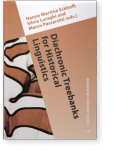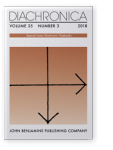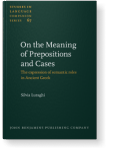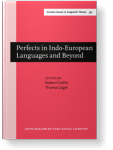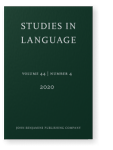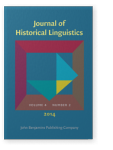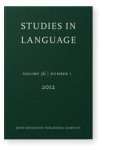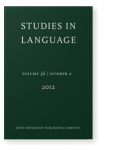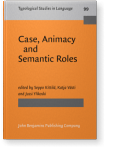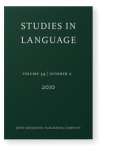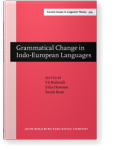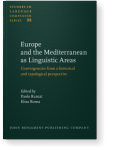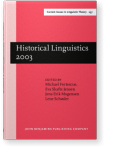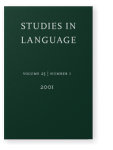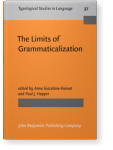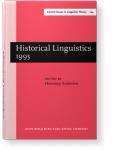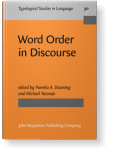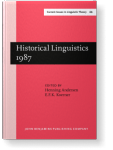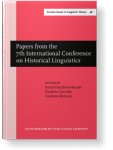Silvia Luraghi
List of John Benjamins publications for which Silvia Luraghi plays a role.
Journal
Partitives cross-linguistically: Dimensions of variation
Edited by Silvia Luraghi and Petra Sleeman
Special issue of Linguistic Variation 23:1 (2023) v, 243 pp.
Subjects Generative linguistics | Typology
Diachronic Treebanks for Historical Linguistics
Edited by Hanne Martine Eckhoff, Silvia Luraghi and Marco Passarotti
[Benjamins Current Topics, 113] 2020. v, 154 pp.
Subjects Computational & corpus linguistics | Historical linguistics | Theoretical linguistics
Diachronic Treebanks
Edited by Hanne Martine Eckhoff, Silvia Luraghi and Marco Passarotti
Special issue of Diachronica 35:3 (2018) v, 153 pp.
Subjects Historical linguistics
Space in Diachrony
Edited by Silvia Luraghi, Tatiana Nikitina and Chiara Zanchi
[Studies in Language Companion Series, 188] 2017. xvii, 373 pp.
Subjects Historical linguistics | Semantics | Syntax | Theoretical linguistics
Perspectives on Semantic Roles
Edited by Silvia Luraghi and Heiko Narrog
[Typological Studies in Language, 106] 2014. vi, 336 pp.
Subjects Semantics | Syntax | Theoretical linguistics | Typology
On the Meaning of Prepositions and Cases: The expression of semantic roles in Ancient Greek
Silvia Luraghi
[Studies in Language Companion Series, 67] 2003. xii, 366 pp.
Subjects Historical linguistics | Other Indo-European languages | Semantics
2024 Embodied constructions: The encoding of emotions in Ancient Greek Review of Cognitive Linguistics: Online-First Articles | Article
In Ancient Greek two-place verbs can take three different argument structure constructions, with nominative first arguments and either accusative or genitive or dative second arguments. While the accusative is the default case across all verb classes, the genitive indicates low agentivity of the… read more
2023 Beyond affectedness – partitive objects and degrees of agenthood in Ancient Greek Partitives cross-linguistically: Dimensions of variation, Luraghi, Silvia and Petra Sleeman (eds.), pp. 95–123 | Article
In several ancient and modern Indo-European languages, the partitive-genitive may be used in place of the accusative to encode the second argument of two-place verbs. In Ancient Greek the two types of object encoding can alternate with change-of-state verbs, alternation being viewed as connected… read more
2023 Crosslinguistic variation in partitives: An introduction Partitives cross-linguistically: Dimensions of variation, Luraghi, Silvia and Petra Sleeman (eds.), pp. 1–27 | Review article
2020 Introduction. The added value of diachronic treebanks for historical linguistics Diachronic Treebanks for Historical Linguistics, Eckhoff, Hanne Martine, Silvia Luraghi and Marco Passarotti (eds.), pp. 1–14 | Miscellaneous
2020 Chapter 11. The Hittite periphrastic perfect Perfects in Indo-European Languages and Beyond, Crellin, Robert and Thomas Jügel (eds.), pp. 377–410 | Chapter
In Hittite, the meaning associated with the Proto-Indo-European perfect, i.e. to indicate a state resulting from a change-of-state event, was covered by compound verb forms consisting of the -ant- participle plus the finite forms of the verbs ḫar(k)- “have” and eš- “be”. The origin and the… read more
2020 From verb to New Event Marker: A new look at the Hittite pai- and uwa- constructions Studies in Language 44:4, pp. 788–811 | Article
In Hittite, deictic motion verbs pai- ‘go’ and uwa- ‘come’ may co-occur in a monoclausal structure with a second verb that carries the lexical meaning. As yet, their exact function remains obscure. I argue that motion verbs involved in such construction underwent transcategorization and function… read more
2020 Non-configurationality in diachrony: Correlations in local and global networks of Ancient Greek and Latin Diachronic Treebanks for Historical Linguistics, Eckhoff, Hanne Martine, Silvia Luraghi and Marco Passarotti (eds.), pp. 69–94 | Chapter
Non-configurationality is a linguistic property associated with free word order, discontinuous constituents, including NPs, and null anaphora of referential arguments. Quantitative metrics, based both on local networks (syntactic trees and word order within sentences) and on global networks… read more
2018 The added value of diachronic treebanks for historical linguistics Diachronic Treebanks, Eckhoff, Hanne Martine, Silvia Luraghi and Marco Passarotti (eds.), pp. 297–309 | Introduction
2018 Non-configurationality in diachrony: Correlations in local and global networks of Ancient Greek and Latin Diachronic Treebanks, Eckhoff, Hanne Martine, Silvia Luraghi and Marco Passarotti (eds.), pp. 367–392 | Article
Non-configurationality is a linguistic property associated with free word order, discontinuous constituents, including NPs, and null anaphora of referential arguments. Quantitative metrics, based both on local networks (syntactic trees and word order within sentences) and on global networks… read more
2017 Differential Goal marking vs. differential Source marking in Ancient Greek Space in Diachrony, Luraghi, Silvia, Tatiana Nikitina and Chiara Zanchi (eds.), pp. 119–146 | Chapter
Differential marking of Goal and Source is a relatively underresearched topic. Available cross-linguistic evidence points toward two possible triggers of differential marking of spatial relations, that is, nouns that denote spatial regions and animate nouns. In this paper, differential Goal and… read more
2017 Space in Diachrony: An introduction Space in Diachrony, Luraghi, Silvia, Tatiana Nikitina and Chiara Zanchi (eds.), pp. xi–xviii | Miscellaneous
2015 Asymmetries in Italian temperature terminology The Linguistics of Temperature, Koptjevskaja-Tamm, Maria (ed.), pp. 333–353 | Article
The Italian system of temperature terminology features the basic terms caldo ‘hot’ and freddo ‘cold’, two intermediate terms, tiepido ‘warm’ and fresco ‘cool’, and two terms for extreme temperature, bollente ‘very hot’ and gelato ‘ice-cold’, and might look remarkably symmetrical. However, a closer… read more
2015 Hate and anger, love and desire: The construal of emotions in Homeric Greek Historical Linguistics 2013: Selected papers from the 21st International Conference on Historical Linguistics, Oslo, 5-9 August 2013, Haug, Dag T.T. (ed.), pp. 233–256 | Article
In Homeric Greek verbs that indicate negative emotions such as anger, hate, and envy take the NominativeDative construction, while verbs that indicate love, desire, and affection take the NominativeGenitive construction. The two constructions are typical of different verb classes: the former mainly… read more
2014 Plotting diachronic semantic maps: The role of metaphors Perspectives on Semantic Roles, Luraghi, Silvia and Heiko Narrog (eds.), pp. 99–150 | Article
The paper discusses patterns of polysemy among semantic roles in cross-linguistic perspective, and the possible way in which such polysemies come into being through meaning extension of morphemes (cases and adposition) that encode semantic roles. Semantic extension is described based on commonly… read more
2014 Perspectives on semantic roles: An introduction Perspectives on Semantic Roles, Luraghi, Silvia and Heiko Narrog (eds.), pp. 1–22 | Article
2014 Editors’ corner Journal of Historical Linguistics 4:2, pp. 159–160 | Article
2012 Basic valency orientation and the middle voice in Hittite Studies in Language 36:1, pp. 1–32 | Article
This paper discusses basic valency orientation in Hittite, based on the typology proposed in Nichols et al. (2004). Verb pairs usually employed to test basic valency indicate the clearly transitivizing character of this language; a closer scrutiny of intransitive verbs further reveals the existence… read more
2012 Review of Welo (2011): Indo-European syntax and pragmatics: contrastive approaches Studies in Language 36:2, pp. 449–453 | Review
2011 The coding of spatial relations with human landmarks: From Latin to Romance Case, Animacy and Semantic Roles, Kittilä, Seppo, Katja Västi and Jussi Ylikoski (eds.), pp. 209–234 | Article
The paper discusses the coding of location and direction with respect to human entities, and analyzes the change undergone by the Latin coding system with its outcomes in the Romance languages. Latin features different coding strategies depending on whether location and direction relate to the… read more
2010 Review of Good (2008): Linguistic universals and language change Studies in Language 34:2, pp. 453–461 | Review
2009 The origin of the feminine gender in PIE: An old problem in a new perspective Grammatical Change in Indo-European Languages: Papers presented at the workshop on Indo-European Linguistics at the XVIIIth International Conference on Historical Linguistics, Montreal, 2007, Bubenik, Vit, John Hewson and Sarah Rose (eds.), pp. 3–13 | Article
2009 The evolution of local cases and their grammatical equivalent in Greek and Latin The Role of Semantic, Pragmatic, and Discourse Factors in the Development of Case, Barðdal, Jóhanna and Shobhana L. Chelliah (eds.), pp. 283–305 | Article
The Indo-European languages attest to a pie system with three local cases: locative, ablative, and (allative) accusative. I will focus on the system of local cases in Ancient Greek and in Latin. Both languages have a reduced number of case distinctions with respect to the pie system; in the field… read more
2007 Mediating culture through language: Contact-induced phenomena in the early translations of the Gospels Europe and the Mediterranean as Linguistic Areas: Convergencies from a historical and typological perspective, Ramat, Paolo and Elisa Roma (eds.), pp. 133–158 | Article
The paper aims to show how translation can transfer certain culture-specific concepts into a different culture, possibly modifying it. It concentrates on the translation of the Greek preposition epí into Latin, Gothic, and Old Church Slavonic in Luke’s Gospel. We argue that, to various extents,… read more
2005 Paths of semantic extension: From cause to beneficiary and purpose Historical Linguistics 2003: Selected papers from the 16th International Conference on Historical Linguistics, Copenhagen, 11–15 August 2003, Fortescue, Michael, Eva Skafte Jensen, Jens Erik Mogensen and Lene Schøsler (eds.), pp. 141–157 | Article
2001 Gapping in Classical Greek prose Studies in Language 25:1, pp. 89–113 | Article
The order of gapping has repeatedly been connected with the basic word order of a language. Such a view is inadequate for free word order languages, such as Classical Greek. Classical Greek allows both right- and leftward gapping; besides, some cases of bi-directional gapping are also attested. All… read more
2001 The development of local particles and adverbs in Anatolian as a grammaticalization process Diachronica 18:1, pp. 31–58 | Article
Summary
The paper aims at giving a unified account of the origins and development of the Anatolian ‘local particles’, which, as such, are not attested in any other Indo-European language. The particles are P2 clitics and mostly co-occur with some type of local expression. The function of the… read more
1998 The Grammaticalization of the Left Sentence Boundary in Hittite The Limits of Grammaticalization, Giacalone Ramat, Anna and Paul J. Hopper (eds.), pp. 189–210 | Article
1995 Prototypically and agenthood in Indo-European Historical Linguistics 1993: Selected papers from the 11th International Conference on Historical Linguistics, Los Angeles, 16–20 August 1993, Andersen, Henning (ed.), pp. 259–268 | Article
1995 The pragmatics of verb initial sentences in some ancient Indo-European languages Word Order in Discourse, Downing, Pamela A. and Michael Noonan (eds.), pp. 355–386 | Article
1993 Verb Serialization and Word Order: Evidence from Hittite Historical Linguistics 1989: Papers from the 9th International Conference on Historical Linguistics, New Brunswick, 14–18 August 1989, Aertsen, Henk and Robert J. Jeffers (eds.), pp. 267–282 | Article
1990 The structure and development of possessive noun phrases in Hittite Historical Linguistics 1987: Papers from the 8th International Conference on Historical Linguistics, Lille, August 30-September 4, 1987, Andersen, Henning and E.F.K. Koerner † (eds.), pp. 309–326 | Article
1989 The relationship between prepositions and cases within Latin prepositional phrases Subordination and Other Topics in Latin: Proceedings of the Third Colloquium on Latin Linguistics, Bologna, 1–5 April 1985, Calboli, Gualtiero (ed.), pp. 253–272 | Article
1987 Patterns of case syncretism in Indo-European languages Papers from the 7th International Conference on Historical Linguistics, Giacalone Ramat, Anna, Onofrio Carruba and Giuliano Bernini (eds.), pp. 355–372 | Article


